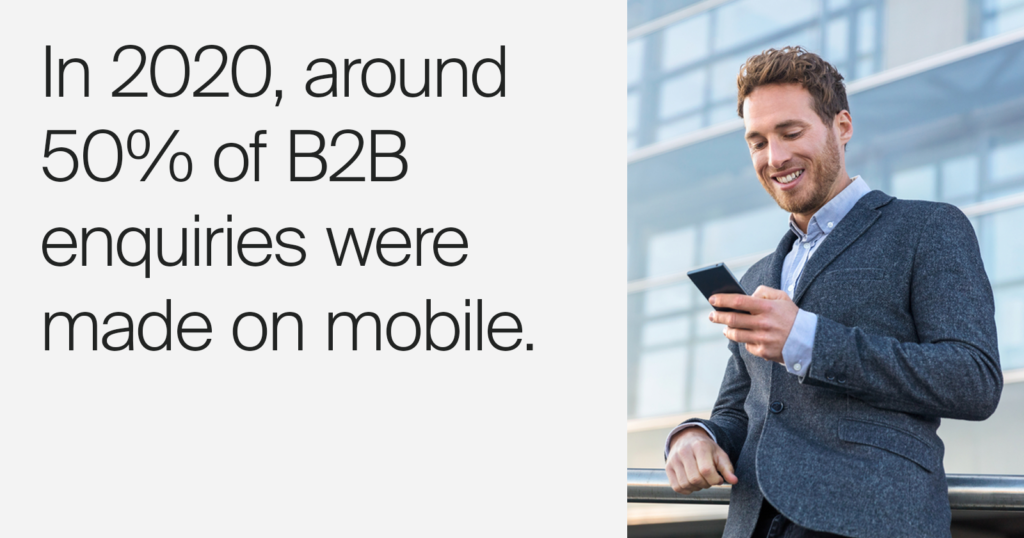In 2007, Apple launched the first iPhone. While there were smartphones before it, the iPhone was the first truly smart device for the masses. The iPhone and the mobile web completely changed the business world, and in just a few short years, we reached the point where mobile browser usage was outstripping the desktop browser. In just the first few months of 2021, according to research by Statista, 55% of all page views come from mobile browsers, and this is not taking into account app usage to see that content either.
Even in the B2B world, where the desktop has been king for so long, we are seeing that shift. In 2020 around 50% of B2B enquiries were made on mobile, according to a report by Smart Insights.

Mobile devices have now become a ubiquitous part of our everyday lives at home and our working lives. Because of this the way that businesses interact with consumers has had to change too.
What are Micro-Moments?
In 2015 Google first coined the term “micro-moments” to refer to the new ways consumers interact with content through their devices. A micro-moment is an intent rich interaction with a smart device, so rather than browsing, the user is going to their device with a specific want or need.
These micro-moments can be categorised as follows:

- Know — The user is reaching for their device because they need to know something. This could be as simple as looking up showtimes for a movie that they want to watch. In this phase of their journey, they are most likely to explore their options or research what is available but not necessarily be ready to buy right away.
- Go — Now that most people have a mobile GPS device on them at all times, it can be a lot easier to find out where to go. The user, in this case, is further along in their journey and is looking up a local business or location, likely with the intent to purchase. Suppose your business has retail locations, your customers might want to look up stock levels online. Recently, new consumer electronics like games consoles, phones and tablets have become harder to purchase due to a worldwide semiconductor shortage, so customers are sometimes willing to go further to secure a hard-to-find item. If you show stock levels online, then your customers can see what you have and might journey further than usual to get it.
- Do — This is where a user wants to do something new. They might be eager to try a new activity, like renting an eScooter in a foreign city to see the sights. They might also be needing to do something they have never done before like changing a tire. In both of these instances, the user is ready to take action.
- Buy — At this point, the user is ready to make a purchase. They are using their device now to either just make the purchase, decide where to purchase, or find out how to buy it. This has some similarities to the “Know” moments in that there is often a research phase to this action, but it is often a lot shorter.
How can you take advantage of these as an SMS marketer?
So now that you know what micro-moments are, it is time to think in terms of your business and how these micro-moments can support your goals and help you better serve your customers. Here are our top tips for leveraging such moments and taking your messaging effort to the next level:
- Be There — One of the first things that you can do that will benefit both your business and your customers is to be there when your customers are having one of the above micro-moments. With SMS best practices and specifically geofencing, this is something you can do very well. For example, say your business is a coffee shop, and you have your customer’s details as part of a loyalty scheme. You can take a look at your customer’s habits. Maybe they always buy a croissant and a coffee on Monday mornings but never visit on Tuesdays. If the user passes within the radius of the geofencing, you can set your campaign to automatically message them a voucher for a free croissant. This way, a customer who might not normally think to visit on Tuesdays might be enticed to do so.
- Be Useful — This is vital for every business in all of the above situations. If a customer comes through to your website, you should have everything optimised for them. Imagine that you are a furniture business owner sending out a message to subscribers about the launch of your new collection. When the subscriber clicks through from the message to your site, you could have a banner pop up directing them to their nearest showroom to see the collection in person. Sometimes if you are sending a promotional message via an OTT app like Viber, the recipient might first see it on another device. In cases like this, you might want users who click the link and come to your site from a desktop browser to see a different page. If you are a car dealership, for example, you might want to direct the viewer to your dealership on your mobile site and offer a car configurator or virtual tour via the desktop browser. A mobile user is more likely to be out of the house, open to visiting your physical location than a desktop user, who might be home or at work.
- Be Consistent — You need to make sure that you are consistent across every method that your customers can use to interact with you. According to a study by Google in 2016, 75% of adults 18-45 will start their purchase journey on one device and end it on another or even in person. You are probably already tracking how your campaigns perform and how your customers make their purchases. But this information should not be siloed off. You want to make sure you can connect the dots between somebody browsing your site online and then coming into the store and making a purchase. A great way to do this is with offer codes — give an offer code for a discount in your SMS campaign and then track how the code is used. Make sure that codes can be redeemed against online orders or retail ones. This consistency will be invaluable to your customers but also help you direct your marketing efforts in the future.
When you are looking to leverage micro-moments one excellent tool is a CPaaS implementation. With GMS Business Communication Suite you can reach out to your audience across multiple channels like SMS, OTT messengers, and push notifications quickly and efficiently. For more information on how CPaaS services can help you drive engagement take a look at this article.

